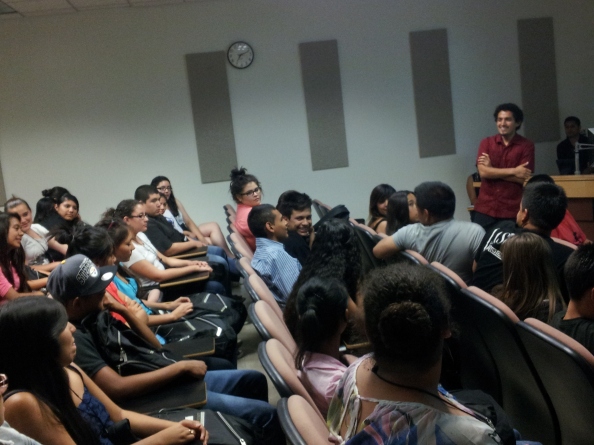I recently had the opportunity to present at a STEM Institute for high school students. What made this unique was it was for CAMP, the College Assistance Migrant Program at Sacramento State University. That meant that all students are Migrant students, a federal definition for families that move with the crop-harvesting seasons. Without over-generalizing, that means these are students that face a more difficult socioeconomic status and in this case are predominantly Latino.
The goal of the institute was to encourage and support these students to pursue STEM degrees in college and STEM careers thereafter. The students were exposed to speakers and role models while taking coursework in math, natural sciences, engineering, and technology.
My 1 and ½ hour presentation was a combination of my life story along with reasons to pursue STEM careers, and addressing concerns and challenges while weaving in culturally appropriate examples.
Through this experience, some points I took away were: the value of culturally relevant STEM outreach to students and parents, the continuing need to diversity STEM outreach, and the receptiveness of students and parents to engage with this outreach.
The students were incredibly responsive and I was energized by their potential—the cultural perspective I brought to them resonated and they opened up with a level of trust sharing their thoughts on STEM and how they saw themselves in the future of STEM fields.
I could have approached them just with charts, data, figures, and a straightforward call to action along with the promise of a more financially stable future with a STEM career. But I eschewed some of that in favor of working to be genuine in front of them first. Instead of just being a presenter in front of them, I took my teaching skillset and did not just do some information dissemination. I made the presentation an opportunity for them to share, talk to each other, and put some “action-oriented” thoughts for their future plans.
I found that this worked for them—they were curious about my background, along with why I showed up wearing a guayabera and huaraches. They wanted to know why I did what I did and how was it that my parents supported me or understood what I wanted to study (natural resources). They verbalized what they were proud of, who they saw as their support network, and how they could address challenges as they continued with higher education and pursued a STEM degree. I did some code-switching, some “Spanglish” and showed culturally relevant visuals—including some Chapulin Colorado and Dolores Huerta. All of this opened the door to sharing why STEM mattered, what they did not know, why they could do it, and why they were valued for the future of STEM.
I also had the opportunity to speak to several of their parents earlier in the week so that they could have a frame of understanding in what STEM meant and how they could support their children—especially since for most of them, their son/daughter would be first in the family to go to college. This is an important factor of outreach in these areas, as often the parents want nothing more than to support their son/daughter but also want an understanding of how they can best do so. In many cases, parents feel they do not have the educational experience or competency to provide more than emotional support. But as parents, they can realize how they can provide a powerful moral and values framework that is valuable for persisting and succeeding in STEM careers. Part of why this is needed is because Latinos can add to diverse ways of thinking and problem-solving that enhances STEM careers—not to mention adding more culturally competency to STEM organizations and businesses that need to connect to a diversifying consumer base and citizenry.
It was also valuable for the parents to understand the scope of “STEM”. We gave many examples of how even “engineer” could encompass many fields of study, from biomedical engineers to electrical engineers, from computer science engineers to financial engineers (talk about a new field!). But with these conversations and presentations, the parents felt comfortable and empowered in how they could have conversations with their children to encourage them in these pursuits—and ask questions and seek support in the educational system.
In the end, this was all an incredibly valuable experience in recognizing the value I can bring in this type of outreach, and that there is still much work to do if we want to continue the diversification of STEM. But the opportunities and potential are there, the students and parents are there, and we need to continue to put the resources behind them—and make these culturally relevant connections.





Ivan Fernando Gonzalez
July 28, 2013
Que bueno. I agree, parents and kids are there, and they can be very receptive if reached in a way that takes their expectations, preferences and language into account. Thanks for your account of a successful day.
Jose Gonzalez
July 28, 2013
Bien dicho Ivan, thank you!